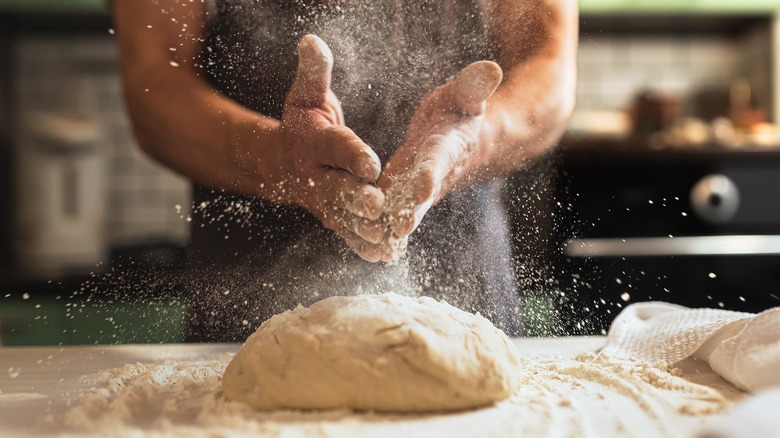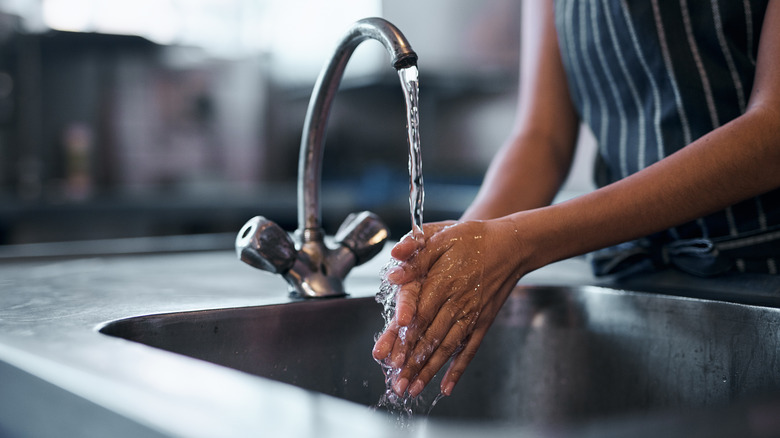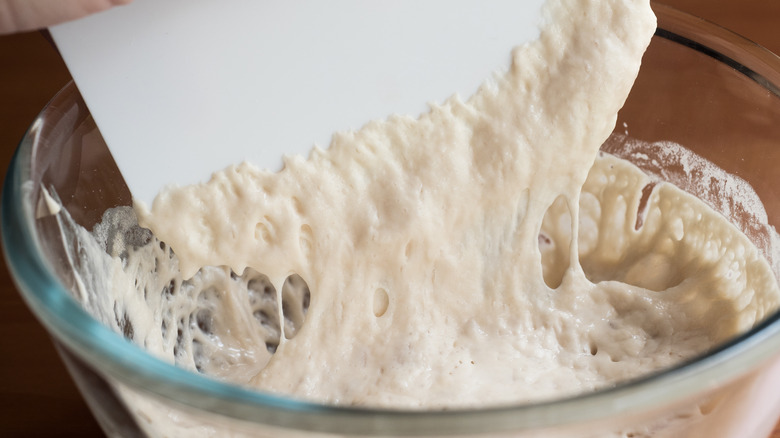The Flour Hack To Get Sticky Dough Off Your Hands Way Easier
Bread baking is a delightfully tactile, hands-on experience — that it, until it comes time to clean up. Rather than scouring sticky fingers under the sink, there is another option to remove leftover dough. All bakers need is a sprinkle of flour.
To solidify and scrape off lingering batter, pour approximately one tablespoon of the flour into your hands. We suggest doing so over the garbage, compost bin, or your dirty workspace after you're done baking to contain the mess. Rub your palms together enthusiastically to dry out the gooey remnants, and watch as pieces of the dough slough off. Then throw out the whole pile.
Bakers will find their hands significantly cleaner, making it easier to wash up. Anything from bread flour to cornmeal will suffice, though waste-conscious cooks will want to dust their hands slowly to avoid tossing too much of the ingredient. This method is helpful even mid-recipe, as your digits will emerge from the flour wash ready to knead a second loaf without a big scrub down.
Protect your plumbing with a flour scrub
The added benefit of removing large chunks of dough before washing is that you'll help keep your drain clear. Thick globs of the yeasted stuff can dry and stick in your pipes; in extreme cases, it can even collect and grow as passing sugars feed the mixture. For regular bakers, this can lead to a clog if paste-like batters are constantly passing through.
Make sure to wipe off bowls and spatulas before placing them in the sink, too. This might be easier to accomplish using a paper towel, rather than a flour rub. Once you've cleared out larger smears of batter, try to wash everything with cold water to avoid further activating the gluten in your mixture.
Seasoned sourdough makers compare the cultured yeast to glue, making it a particularly nasty threat to your kitchen drain, so be sure to take this extra step when you feed your starter and clean out its container. If you're unable to use up your sourdough discard, make sure to trash or compost it — or, allow it to dry on a piece of waxed paper before throwing it out for easier handling.
Clean up quickly with a bowl scraper
Another handy hack for removing sticky dough from both your hands and surfaces is to use a bowl scraper. This tool is an underutilized hero in the kitchen for shuttling and transferring ingredients. When used in bread baking, it can also scoop mixtures after a long rise, or help fold high hydration sourdough before you start kneading, keeping hands mess-free.
Sometimes referred to as a dough scraper or plastic bench scraper, this bendy tool should not be confused with a metal bench scraper. The latter, though helpful for making cinnamon rolls from scratch and portioning doughs, features a horizontal edge designed to cut through puffy mixtures. Bowl scrapers, on the other hand, are made of plastic or silicone, and feature a curved edge that makes them efficient cleanup tools. This rounded component allows the small and bendy piece of plastic to get incredibly close to the surface of dirty bowls and maneuver into small crevices.
The benefit of using this tool before bringing in the flour is that it can help prevent recipe followers from introducing too much of another ingredient. Although cooks can dust their hands to take breaks from kneading, or dip their hands in water or oil before diving into mixing, a quick scrape with the plastic will return missing bits of dough without throwing off your ratios. Finish the bake by rubbing hands and scrapers with flour before rinsing off.



